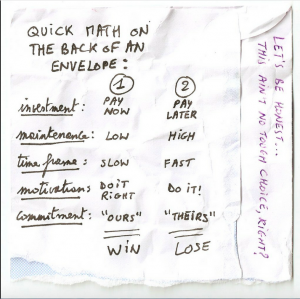Difference between revisions of "Back of the envelope statistics"
(Created page with "==Back of the envelope statistics== File:Bildschirmfoto 2020-04-08 um 11.37.25.png|thumb|left|Back of the envelope calculations give you a first impression about your idea...") |
|||
| Line 5: | Line 5: | ||
[https://www.investopedia.com/terms/b/back-of-the-envelope-calculation.asp Back of the envelope calculations] are rough estimates that are made on the small piece of paper, hence the name. These are extremely helpful to get a quick estimate about the basic numbers for a given formula of principle, thus enable us to get her [https://www.stlouisfed.org/on-the-economy/2020/march/back-envelope-estimates-next-quarters-unemployment-rate quick calculation] with either the goal to check for the plausibility of the assumption, or to derive a simple explanation of the more complex issue. Back of the envelope calculations can be for instance helpful when you want to get a rough estimate about an idea that can be expressed in numbers. Prominent examples for back of the envelope calculations include the dominant character coding of the World Wide Web and the development of the laser. Back of the envelope calculations are fantastic within sustainability science, I think, because they can help us to illustrate complex issues in a more simple form, and they can serve as her guideline for a quick planning. Therefore, they can be used within other more complex forms of methodological applications, such as scenario planning. By quickly calculating different scenarios we can for instance make her plausibility check and focus our approaches on-the-fly. I encourage you to learn back of the envelope calculations in your [https://www.youtube.com/watch?v=bAU1MLRwh7c everyday life], as many of us already do. I learned to love "Tydlig", which is one of the best apps I ever used, but unfortunately I only know her version for my Apple devices. It can however be quite helpful to break numbers down into overall estimates, as the video below illustrates. | [https://www.investopedia.com/terms/b/back-of-the-envelope-calculation.asp Back of the envelope calculations] are rough estimates that are made on the small piece of paper, hence the name. These are extremely helpful to get a quick estimate about the basic numbers for a given formula of principle, thus enable us to get her [https://www.stlouisfed.org/on-the-economy/2020/march/back-envelope-estimates-next-quarters-unemployment-rate quick calculation] with either the goal to check for the plausibility of the assumption, or to derive a simple explanation of the more complex issue. Back of the envelope calculations can be for instance helpful when you want to get a rough estimate about an idea that can be expressed in numbers. Prominent examples for back of the envelope calculations include the dominant character coding of the World Wide Web and the development of the laser. Back of the envelope calculations are fantastic within sustainability science, I think, because they can help us to illustrate complex issues in a more simple form, and they can serve as her guideline for a quick planning. Therefore, they can be used within other more complex forms of methodological applications, such as scenario planning. By quickly calculating different scenarios we can for instance make her plausibility check and focus our approaches on-the-fly. I encourage you to learn back of the envelope calculations in your [https://www.youtube.com/watch?v=bAU1MLRwh7c everyday life], as many of us already do. I learned to love "Tydlig", which is one of the best apps I ever used, but unfortunately I only know her version for my Apple devices. It can however be quite helpful to break numbers down into overall estimates, as the video below illustrates. | ||
| + | ---- | ||
[[Category:Statistics]] | [[Category:Statistics]] | ||
| + | [[Category:Methods]] | ||
The [[Table of Contributors|author]] of this entry is Henrik von Wehrden. | The [[Table of Contributors|author]] of this entry is Henrik von Wehrden. | ||
Revision as of 09:34, 12 February 2021
Back of the envelope statistics
Back of the envelope calculations are rough estimates that are made on the small piece of paper, hence the name. These are extremely helpful to get a quick estimate about the basic numbers for a given formula of principle, thus enable us to get her quick calculation with either the goal to check for the plausibility of the assumption, or to derive a simple explanation of the more complex issue. Back of the envelope calculations can be for instance helpful when you want to get a rough estimate about an idea that can be expressed in numbers. Prominent examples for back of the envelope calculations include the dominant character coding of the World Wide Web and the development of the laser. Back of the envelope calculations are fantastic within sustainability science, I think, because they can help us to illustrate complex issues in a more simple form, and they can serve as her guideline for a quick planning. Therefore, they can be used within other more complex forms of methodological applications, such as scenario planning. By quickly calculating different scenarios we can for instance make her plausibility check and focus our approaches on-the-fly. I encourage you to learn back of the envelope calculations in your everyday life, as many of us already do. I learned to love "Tydlig", which is one of the best apps I ever used, but unfortunately I only know her version for my Apple devices. It can however be quite helpful to break numbers down into overall estimates, as the video below illustrates.
The author of this entry is Henrik von Wehrden.
